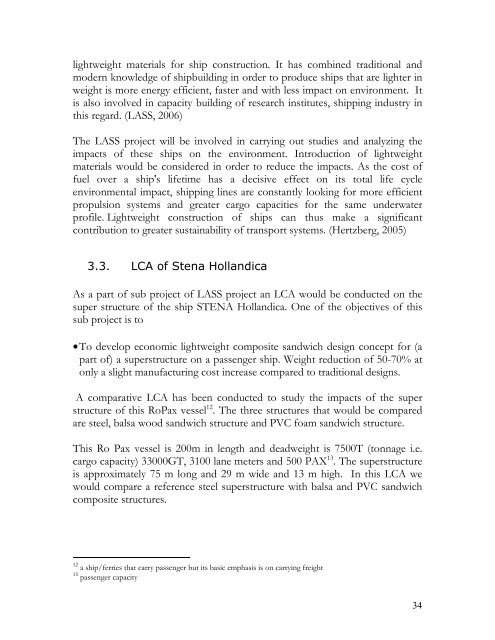Life Cycle Assessment of Fiber Composites_final__rättad
Life Cycle Assessment of Fiber Composites_final__rättad
Life Cycle Assessment of Fiber Composites_final__rättad
Create successful ePaper yourself
Turn your PDF publications into a flip-book with our unique Google optimized e-Paper software.
lightweight materials for ship construction. It has combined traditional and<br />
modern knowledge <strong>of</strong> shipbuilding in order to produce ships that are lighter in<br />
weight is more energy efficient, faster and with less impact on environment. It<br />
is also involved in capacity building <strong>of</strong> research institutes, shipping industry in<br />
this regard. (LASS, 2006)<br />
The LASS project will be involved in carrying out studies and analyzing the<br />
impacts <strong>of</strong> these ships on the environment. Introduction <strong>of</strong> lightweight<br />
materials would be considered in order to reduce the impacts. As the cost <strong>of</strong><br />
fuel over a ship's lifetime has a decisive effect on its total life cycle<br />
environmental impact, shipping lines are constantly looking for more efficient<br />
propulsion systems and greater cargo capacities for the same underwater<br />
pr<strong>of</strong>ile. Lightweight construction <strong>of</strong> ships can thus make a significant<br />
contribution to greater sustainability <strong>of</strong> transport systems. (Hertzberg, 2005)<br />
3.3. LCA <strong>of</strong> Stena Hollandica<br />
As a part <strong>of</strong> sub project <strong>of</strong> LASS project an LCA would be conducted on the<br />
super structure <strong>of</strong> the ship STENA Hollandica. One <strong>of</strong> the objectives <strong>of</strong> this<br />
sub project is to<br />
• To develop economic lightweight composite sandwich design concept for (a<br />
part <strong>of</strong>) a superstructure on a passenger ship. Weight reduction <strong>of</strong> 50-70% at<br />
only a slight manufacturing cost increase compared to traditional designs.<br />
A comparative LCA has been conducted to study the impacts <strong>of</strong> the super<br />
structure <strong>of</strong> this RoPax vessel 12 . The three structures that would be compared<br />
are steel, balsa wood sandwich structure and PVC foam sandwich structure.<br />
This Ro Pax vessel is 200m in length and deadweight is 7500T (tonnage i.e.<br />
cargo capacity) 33000GT, 3100 lane meters and 500 PAX 13 . The superstructure<br />
is approximately 75 m long and 29 m wide and 13 m high. In this LCA we<br />
would compare a reference steel superstructure with balsa and PVC sandwich<br />
composite structures.<br />
12 a ship/ferries that carry passenger but its basic emphasis is on carrying freight<br />
13 passenger capacity<br />
34
















